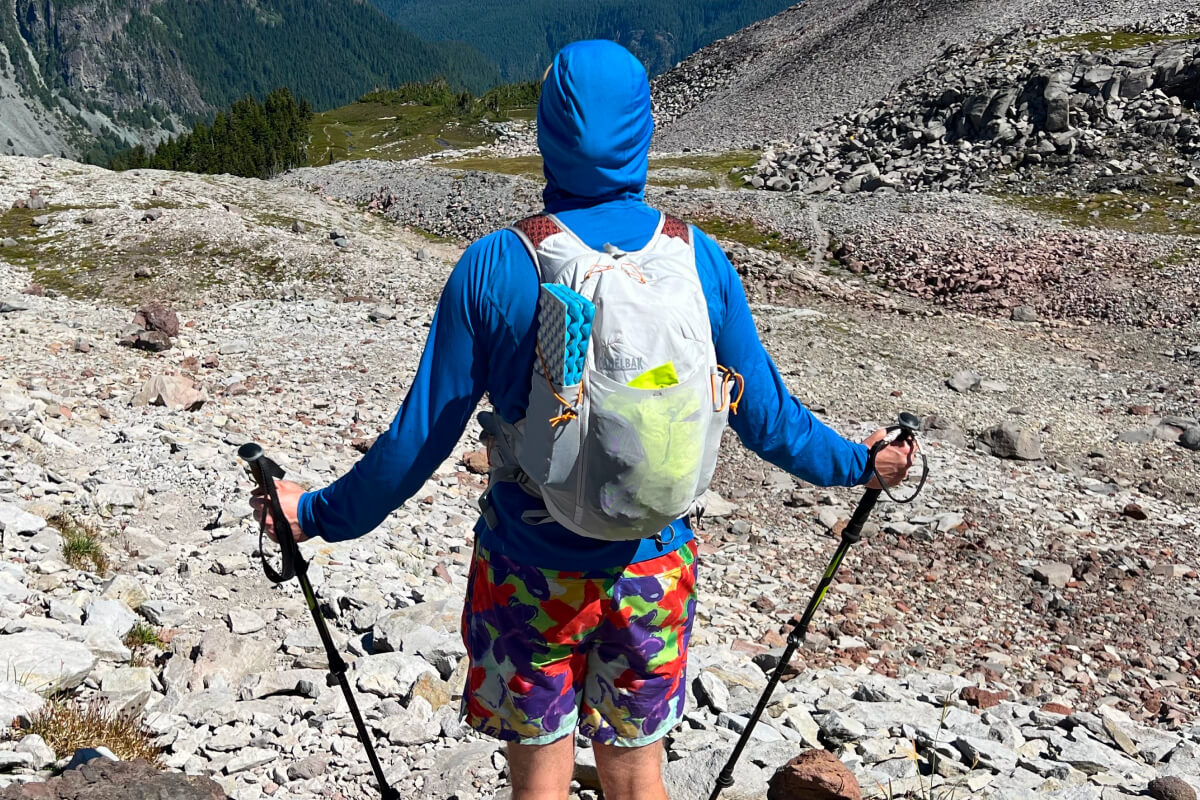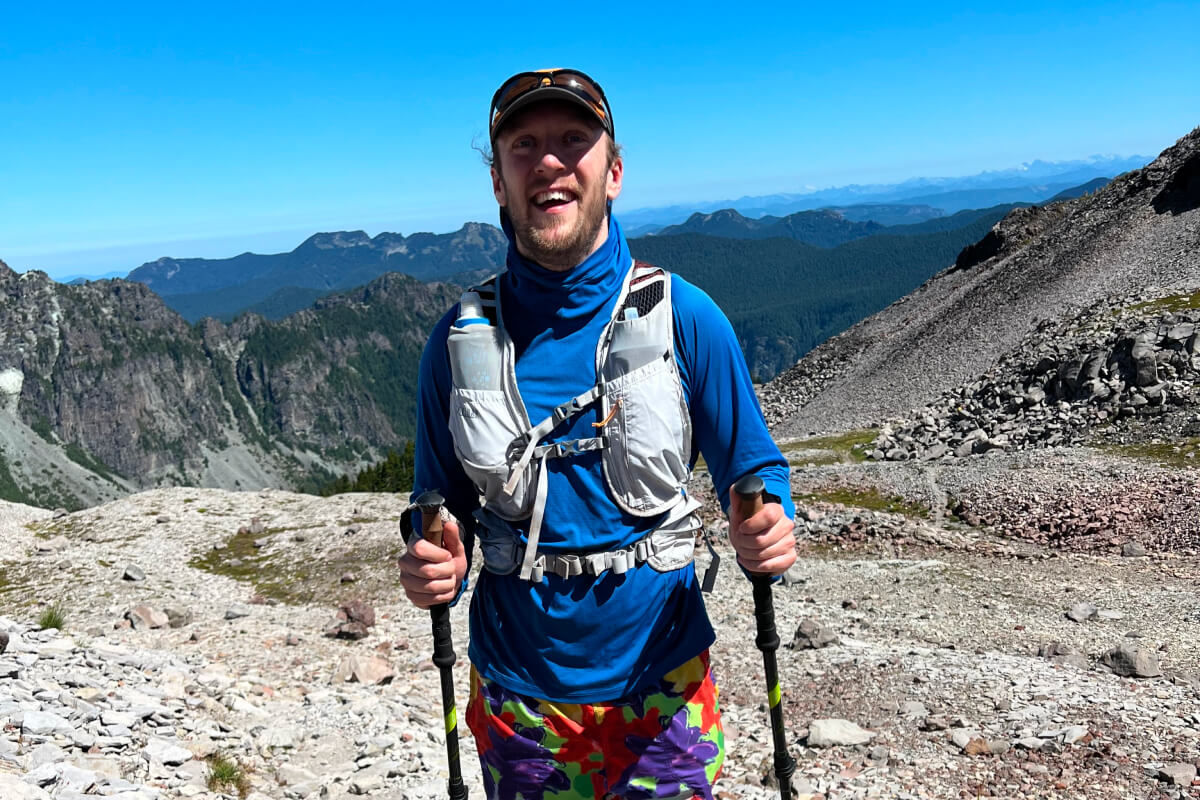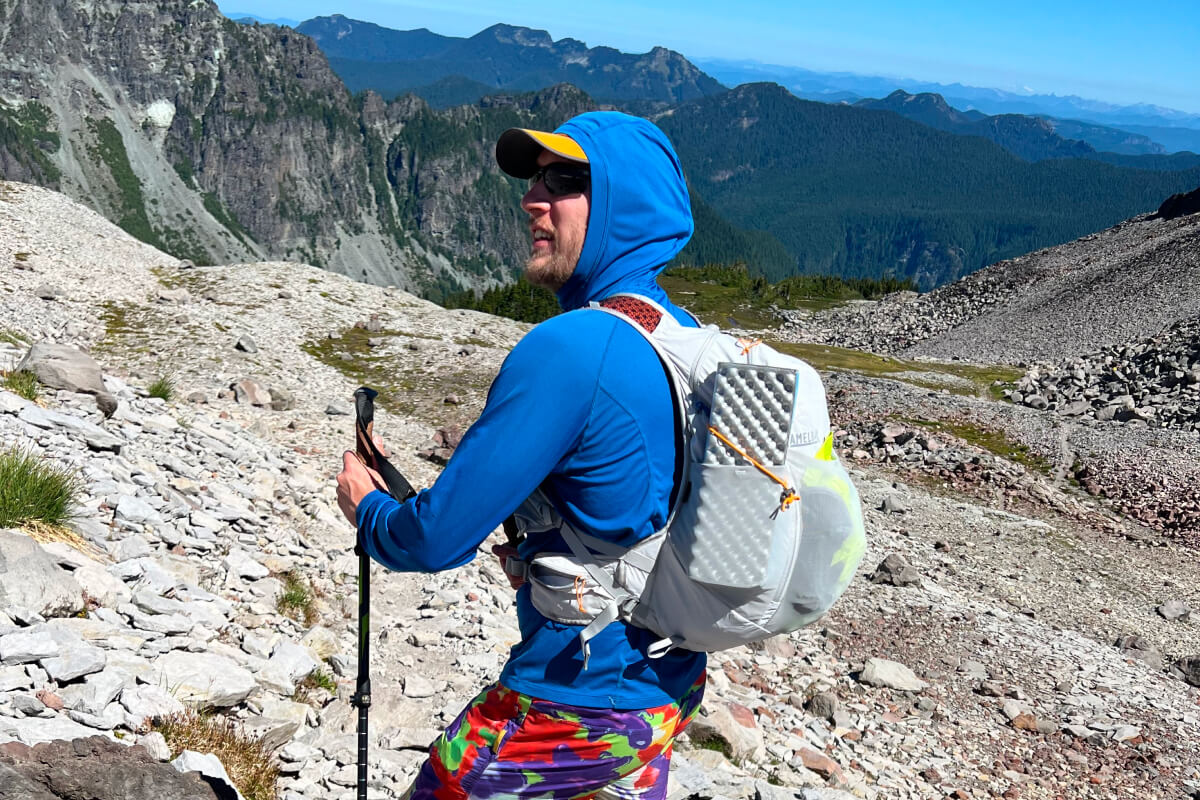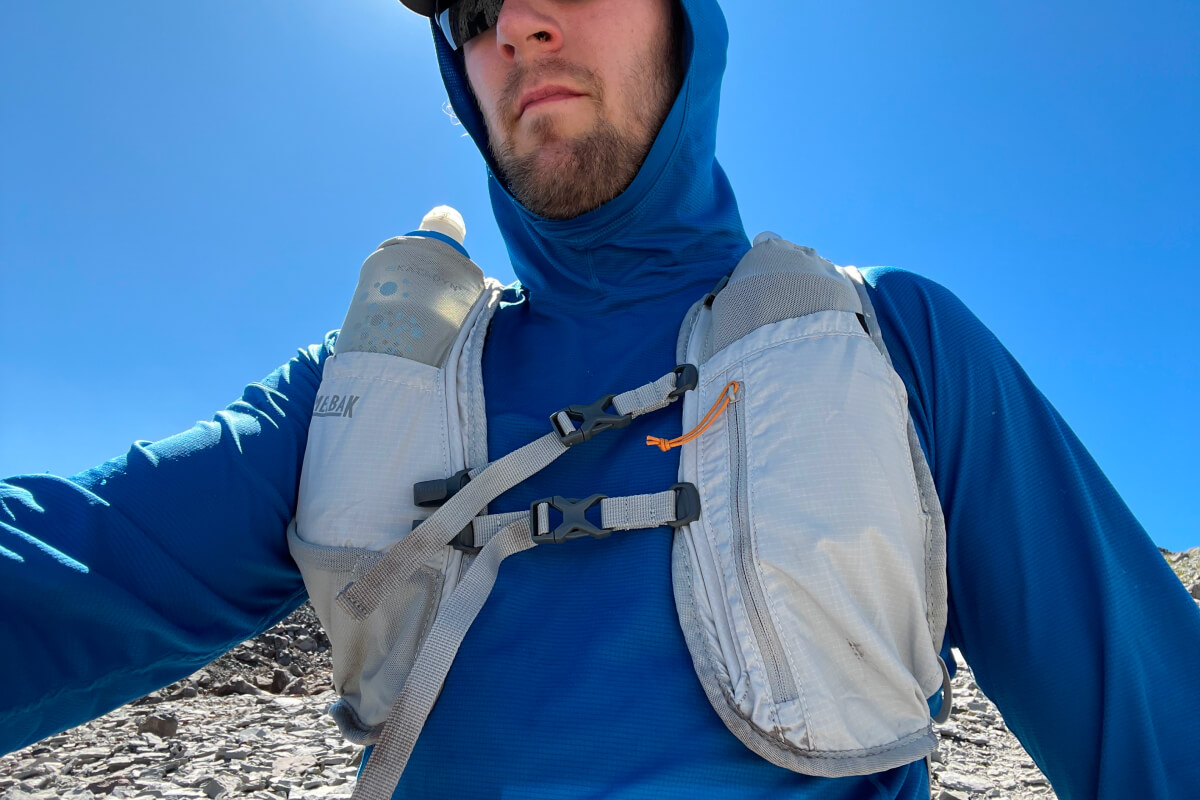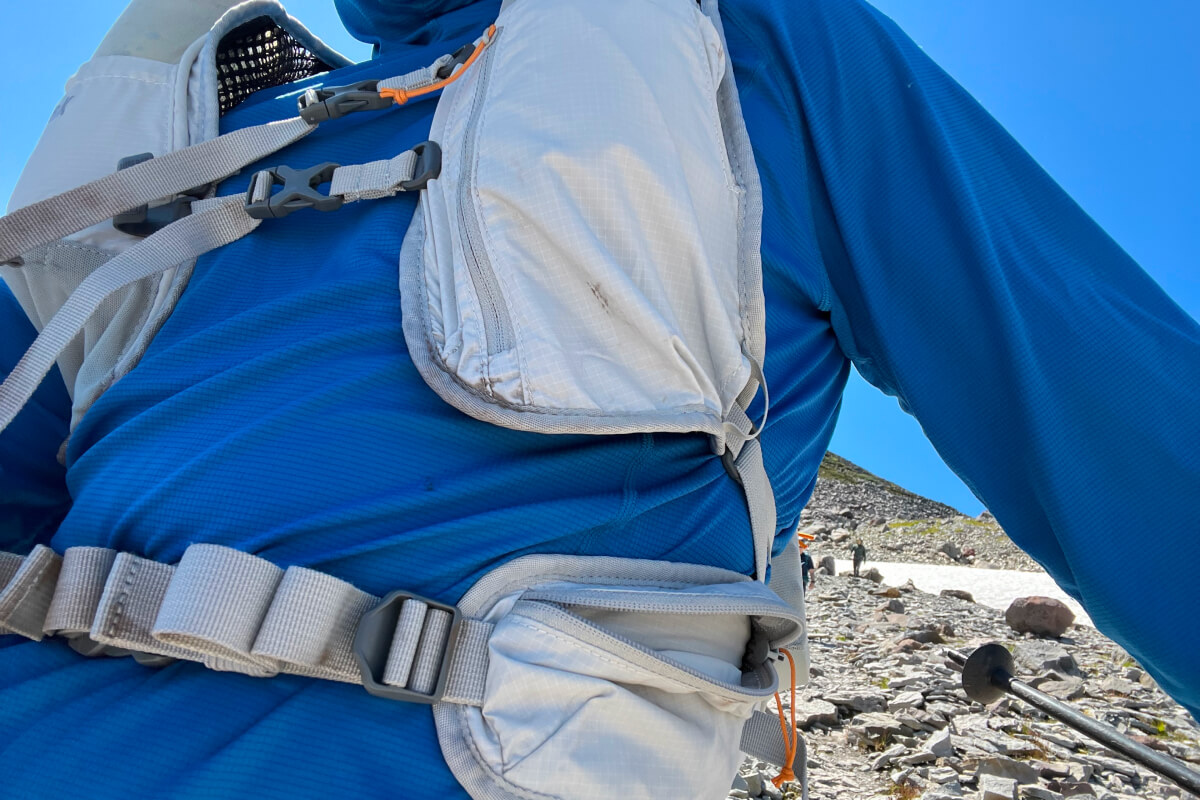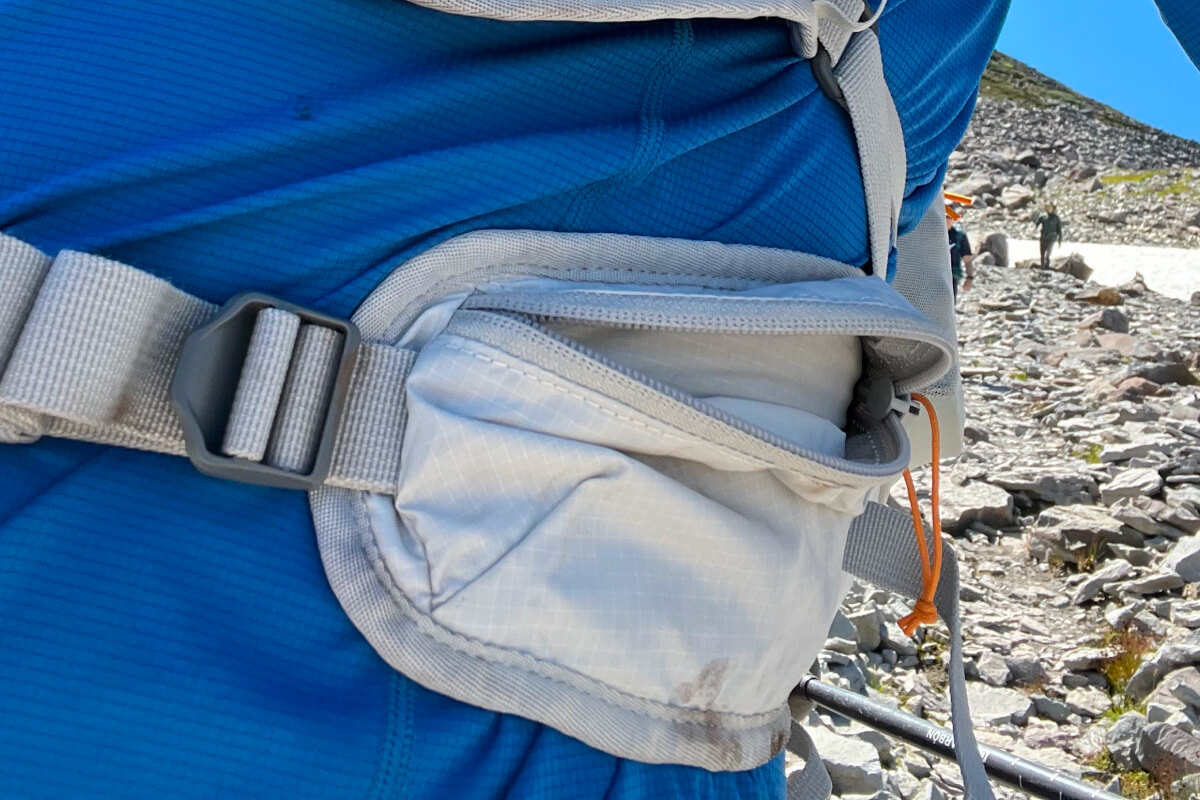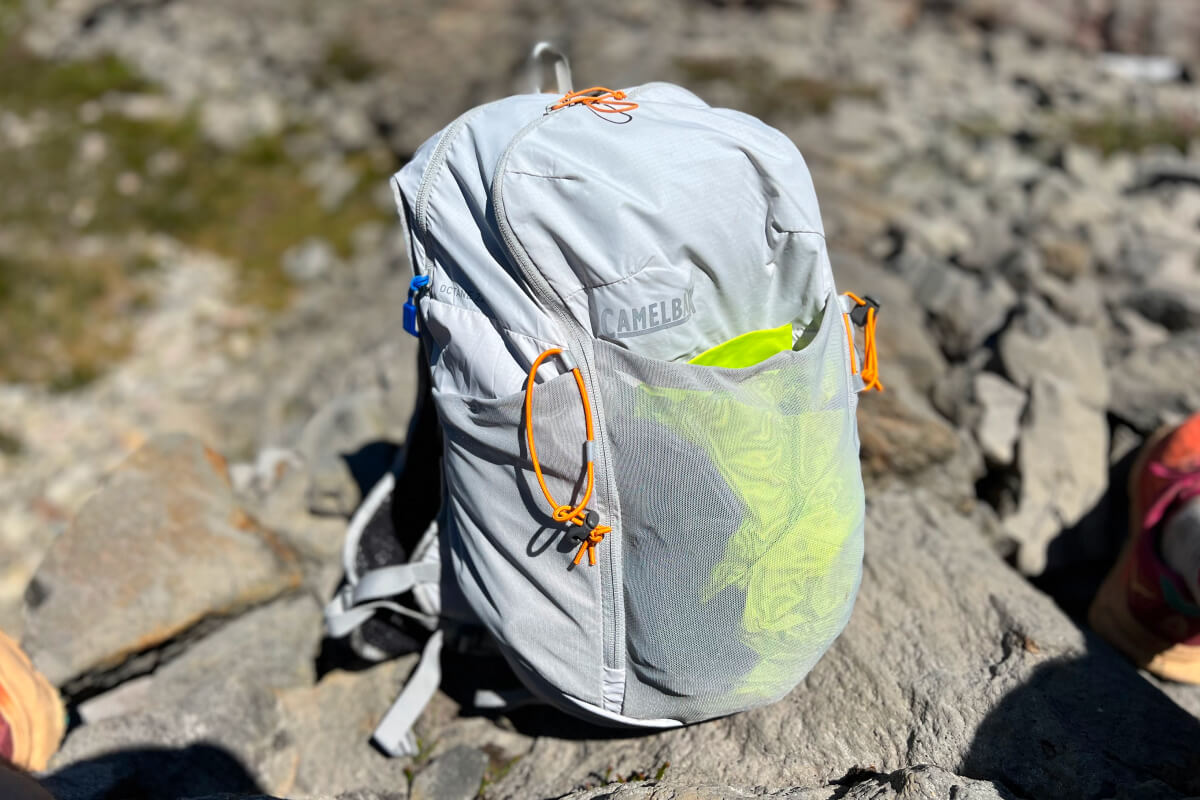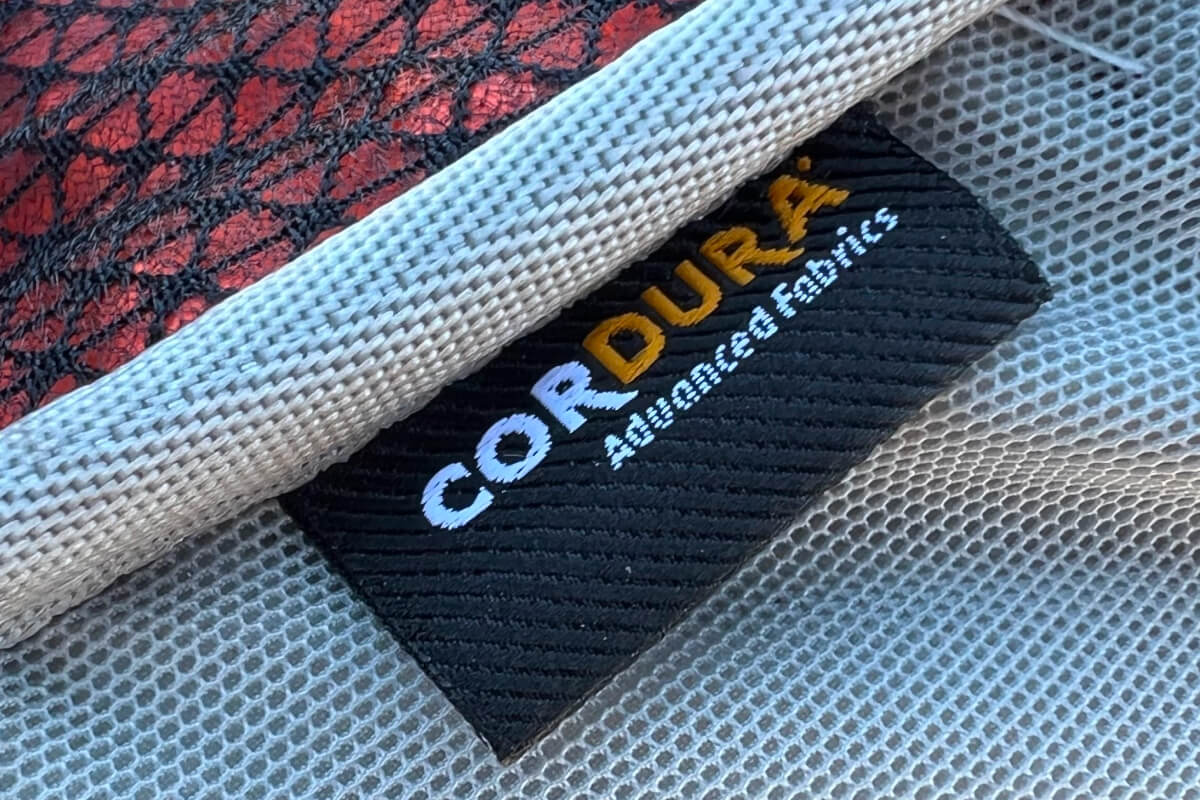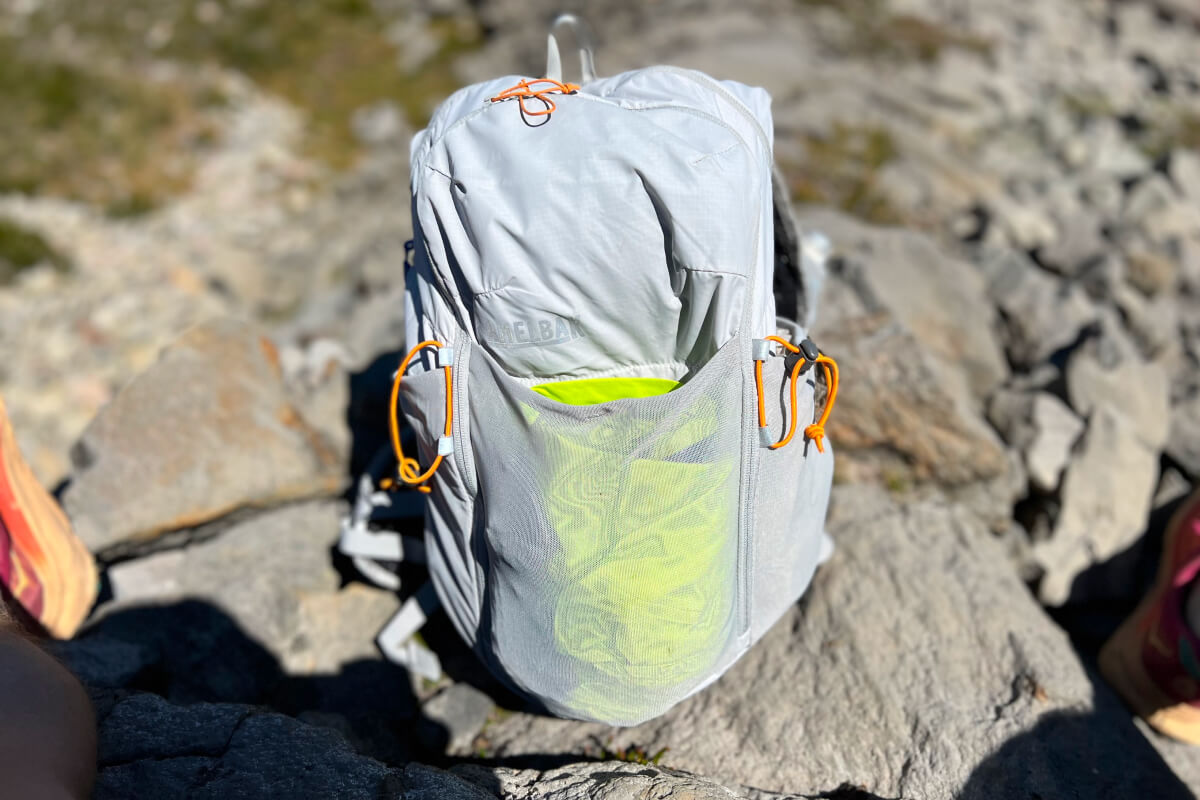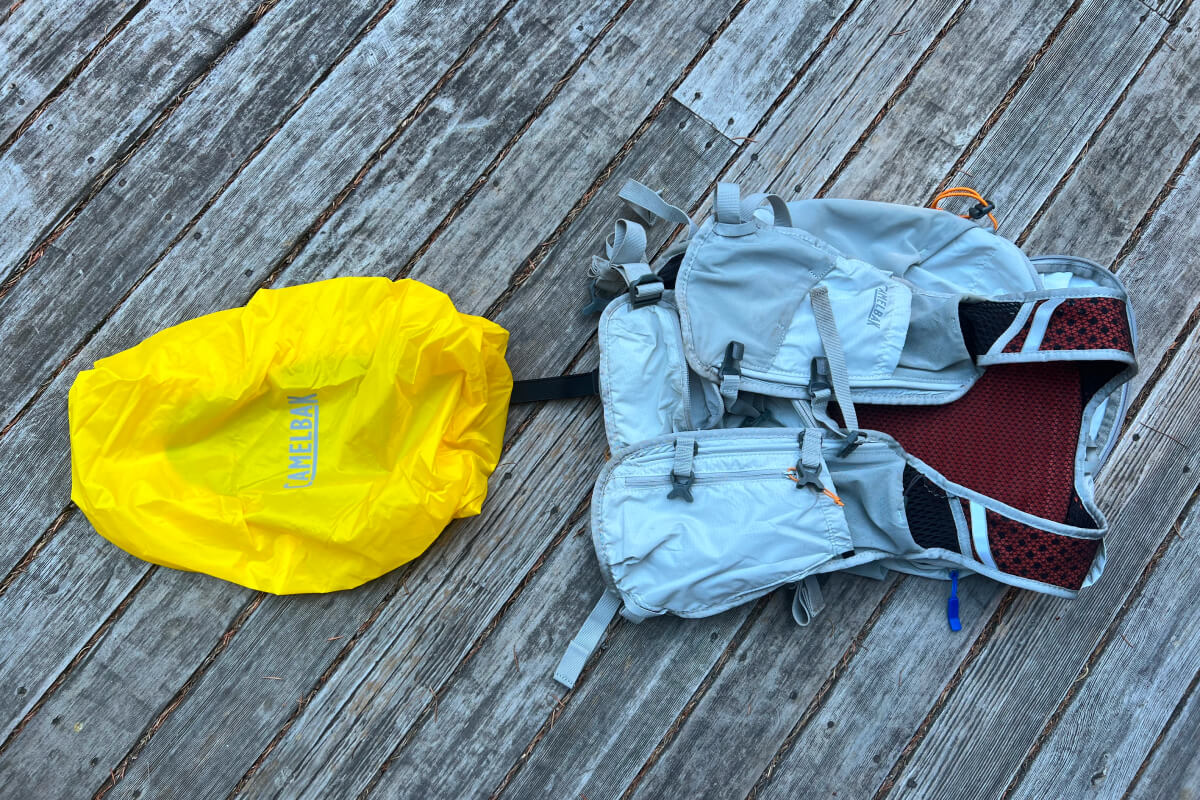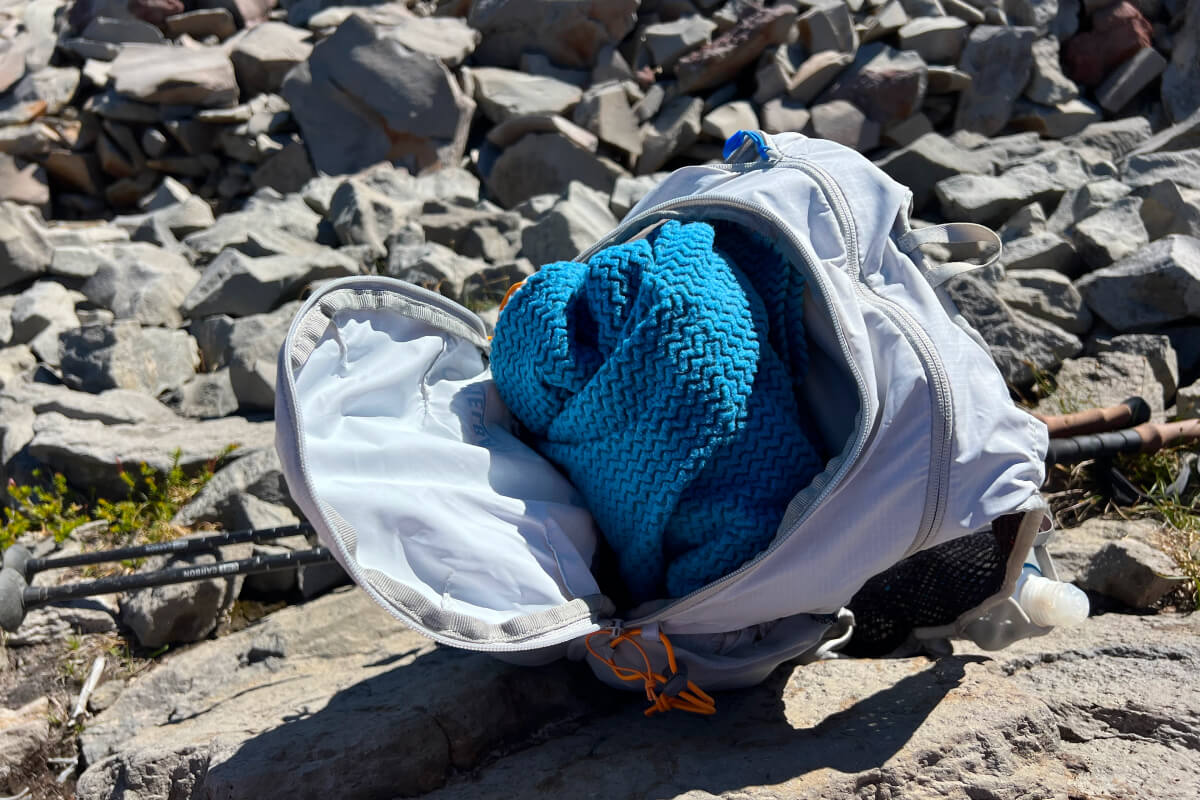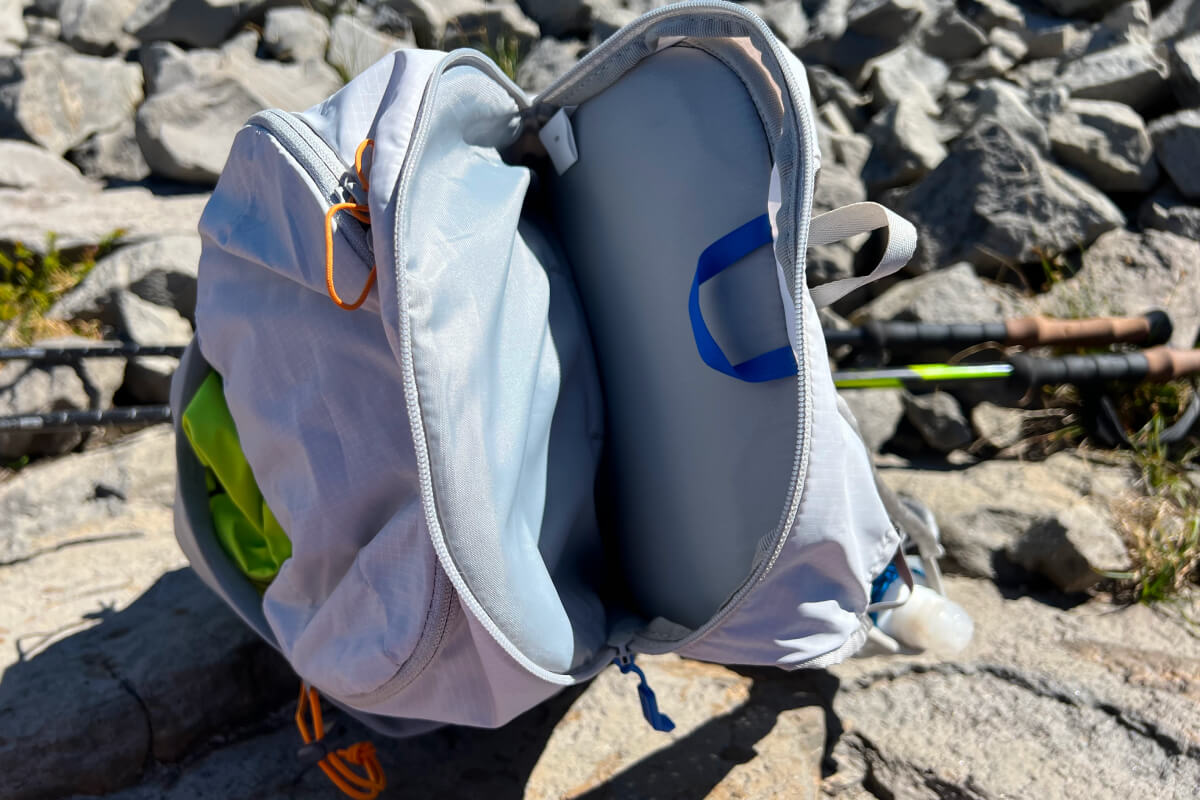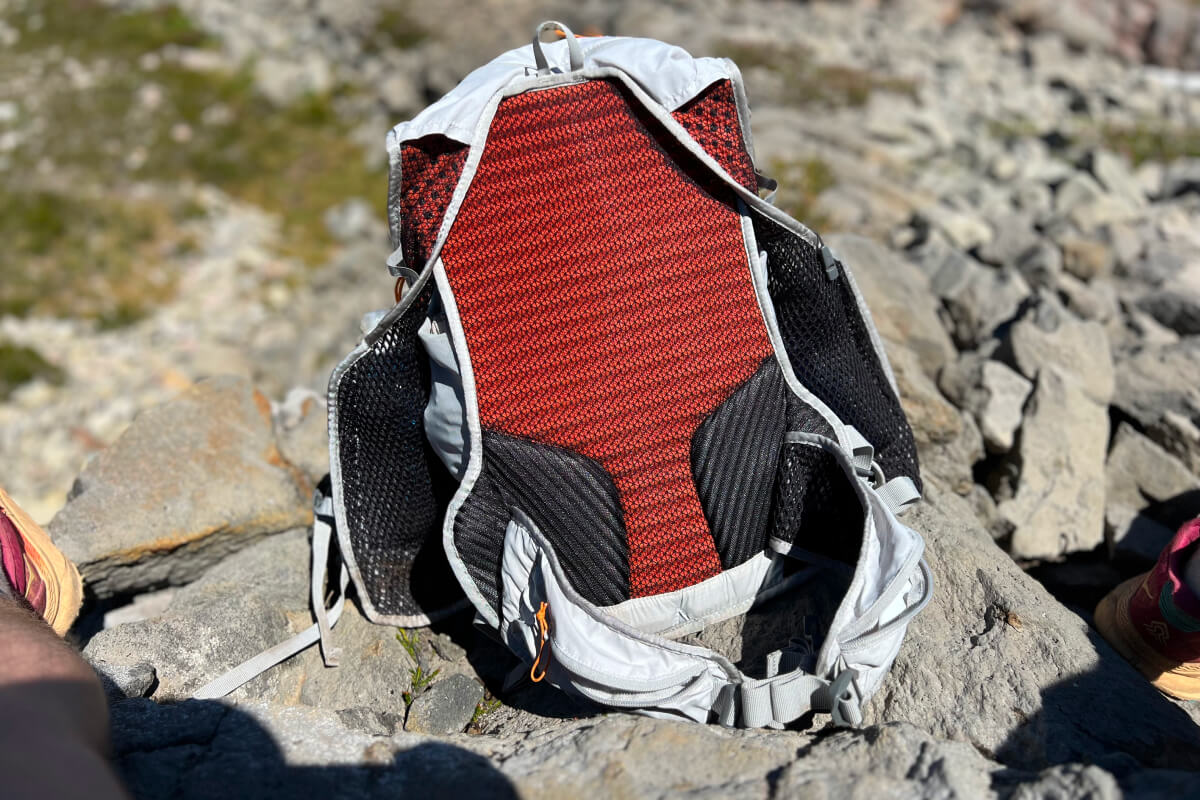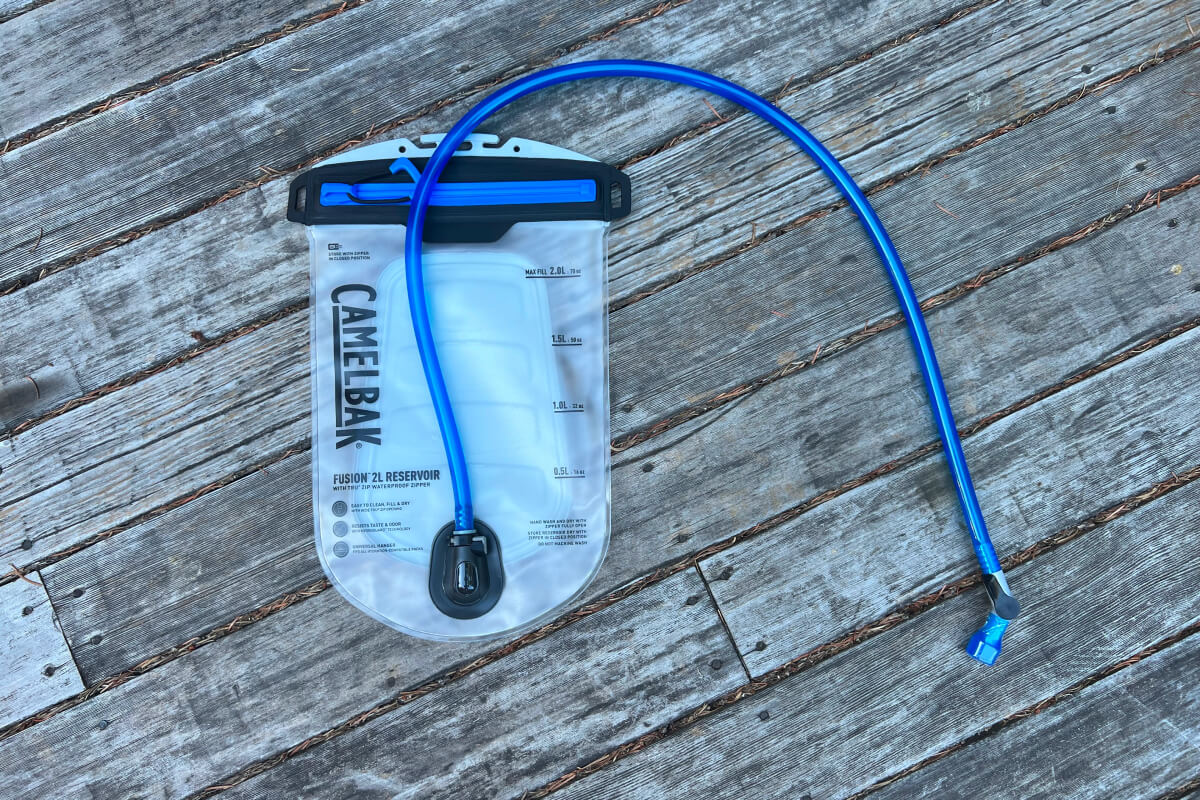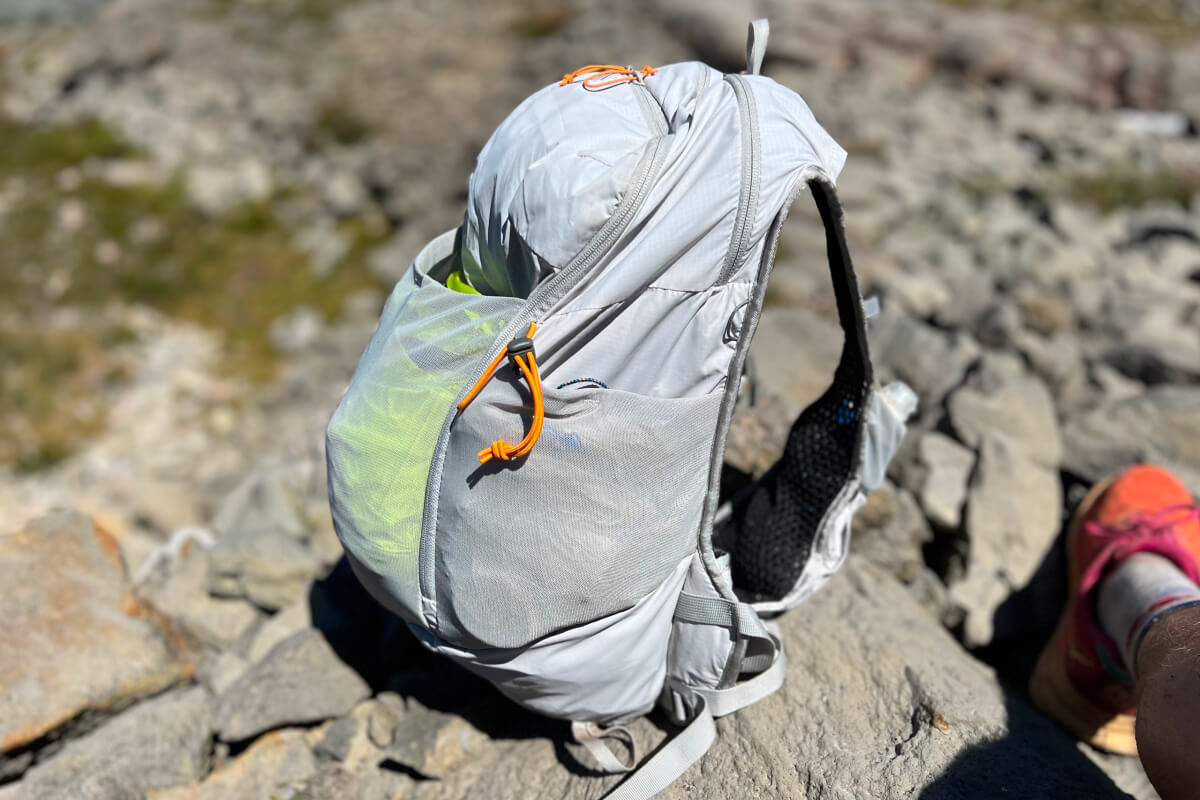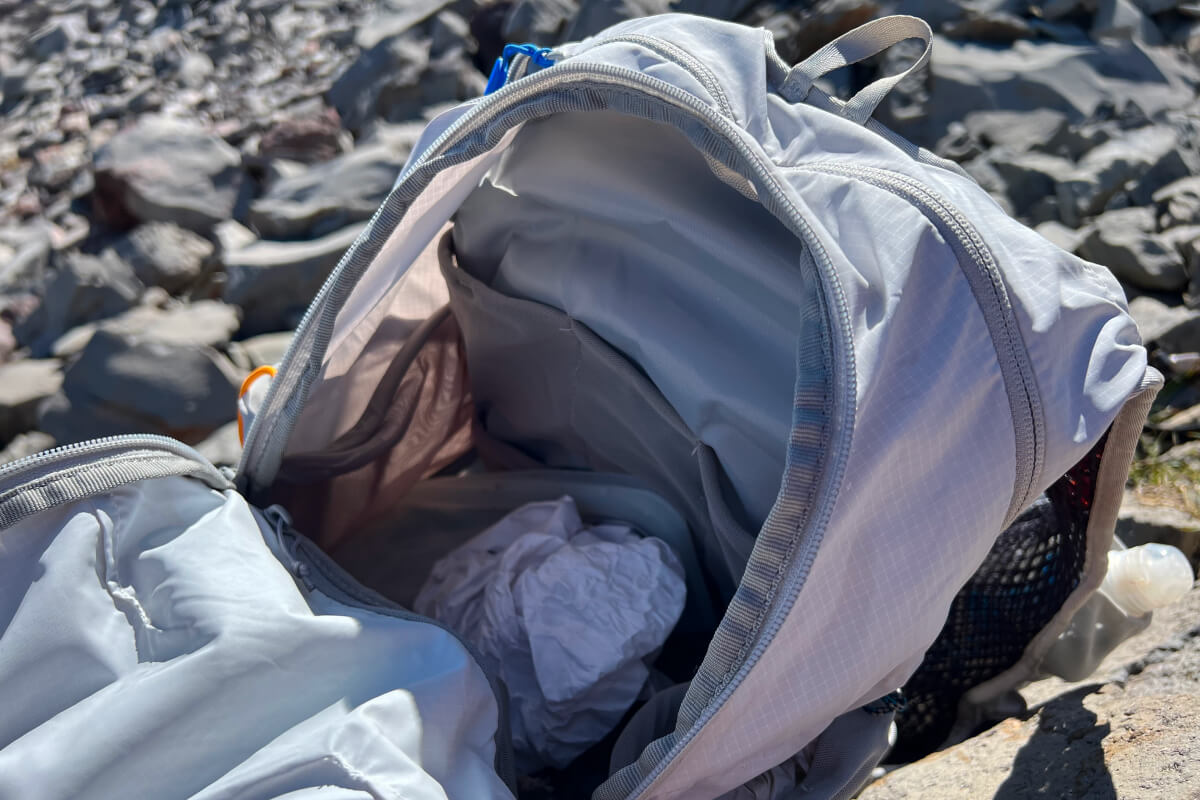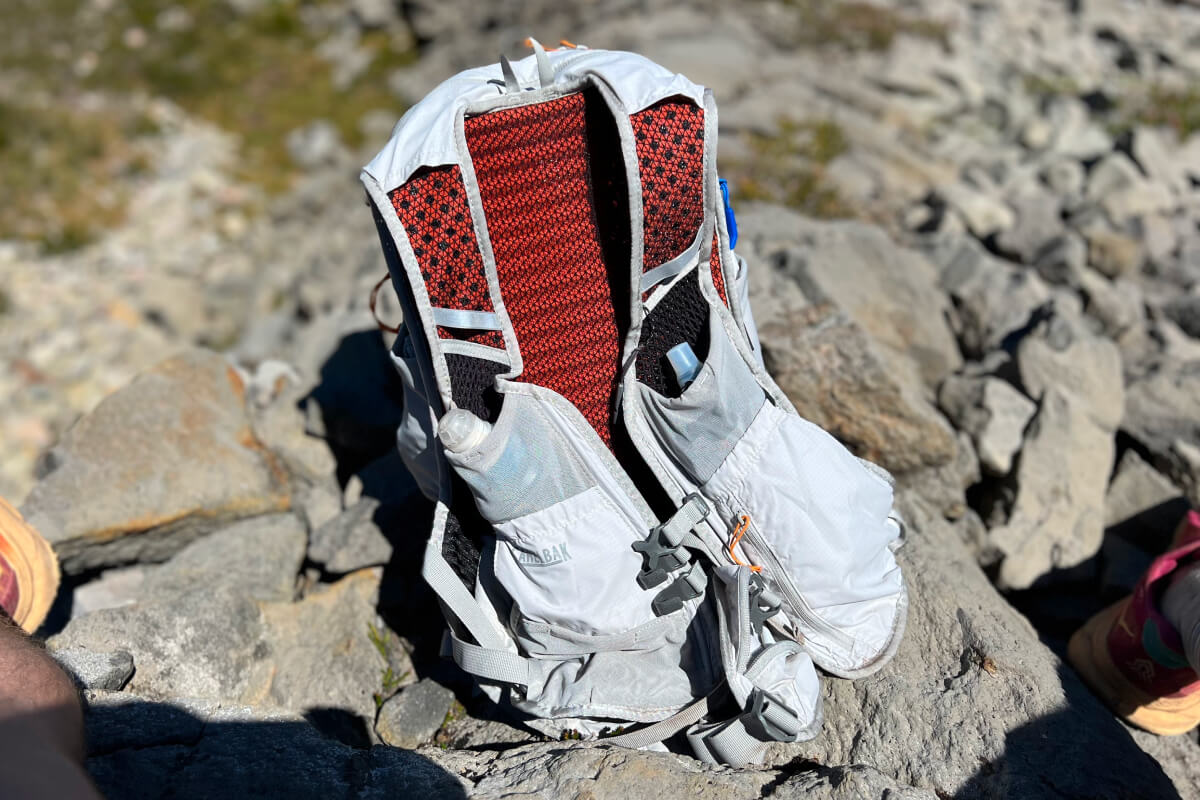CamelBak Octane 22 Review
A hydration backpack with a running vest harness and more features than you can shake a stick at
No daypack we’ve ever tested has more built-in features than the CamelBak Octane 22 Hydration Backpack with running vest harness (shop now). To say this pack is smothered in features barely does it justice. Most of the bells and whistles we like, though some feel a bit slapdash. Nonetheless, Octane 22 delivers an effective hiking version of the type of pack previously limited to trail runners. It is as unique as it is perfect for high mileage days where efficiency and security of fit matters most.
- Weight: 31 oz
- Price: $170
- Materials: Cordura Nylon Ripstop
- Back Panel: 1/4″ foam back panel
- Main Compartment Volume: 22L
- External Volume: 8L (estimate)
- Pros: Full size external mesh pockets. Secure, wide running-vest style harness. Frontal water storage. Comes with own bladder & rain cover.
- Cons: Lots of pockets that are either too small or strangely placed. Clamshell flops open. Feature overload? Sternum strap drift.
Note From Tester For CamelBak Octane 22 Review
I took the CamelBak Octane 22 out for a summer day hike to assess for the purposes of this review. The end result was a very positive experience with the pack. However, despite our team collectively having decades of experience testing hiking packs, this pack has only been used once. I will update this review should any of our opinions or experiences change after further testing.
Additionally, I chose to remove the hydration bladder before embarking on this hike, though not due to any malfunction, discontent, or issue with that particular component. This was a hike with frequent, easy access to fresh stream water, so the trusty Katadyn .6L BeFree Filter in conjunction with a CamelBak 17 oz QUICK STOW Flask, both stored in front-of-vest hydration pockets, were more than adequate and superior to carrying 2-3L of water. That’s far heavier than necessary!
Construction & Features – Vest Harness & Hip Belt
Where else to start than the running vest harness? What calls to us most loudly is how wide these straps are. Your author owns five backpacks with running vest harness style straps, and the CamelBak Octane 22 easily has the widest. That’s generally a good thing as it helps to disperse the load and creates a really secure fit with extra friction and a wide array of rib cage pressure. However, it does have an odd look about it.
Each side of the vest has a slightly different configuration. The wearer’s right has a large mesh pocket, a large soft bottle pocket, and a lower mesh pocket, likely for wrappers or gels. The right also is topped by a mesh pocket, and beneath it lies a large soft bottle pocket. The outside of this pocket has a zipper. Two static nylon webbing sternum straps connect the two sides of the vest. The soft bottle pockets can fit sizes up to a half liter. While the sternum straps are very simple and easy to adjust on their bar, this configuration causes the connection points to move as they pack gets bumped or tugs.
One thing that annoyed us about the vest was the fact that when you store a full half liter sized soft bottle, it collapses the available space in all of the surrounding bonus pockets, at which point the largest sized object they can store is an energy gel packet.
The top of the vest which sits directly above the shoulders is made of a comfy aerated foam and mesh. We didn’t feel shoulder pressure taking this pack out, which was nice.
We now move to the hip belt. This is an integrated feature, and cannot be removed. As it’s constructed from fabric and mesh (no foam), it is fairly floppy and unstructured. However, it is much more comfortable than a nylon webbing cord which is common in packs like these, and the sheer width of it disperses pressures and never digs in. What’s more, each side has a zippered snack pocket.
However, when you put on the pack, the pockets wrap around your hips and it sits in a way that basically eliminates 60% of the volume of the pocket. They don’t look big and they feel even smaller. Each pocket is good for a Clif Bar or a couple of gels, not a phone. A reverse-pull nylon webbing closes off the front side with a buckle.
The excellent security of the vest harness makes us question what purpose the hip belt serves. Sure, it adds a bit of sway security, and a titch of weight transfer (though not a lot), but the top half is is so effective that it kind of makes the hip belt obsolete. Doubly so given how undersized the snack pockets are.
Construction & Features – Pack Body
The back panel is a ridge-and-valley wave foam configuration that is topped off with a layer of mesh. The foam adds some much needed structure to the backpack. Overall it does a good job of blocking lumps, dumping heat, and is overall quite pleasant and effective. Good job CamelBak!
The rest of the pack body is made with a 75d Cordura ripstop nylon that is at least in some part comprised of recycled materials. It feels like a good compromise between durability/strength and low-bulk/low weight.
The outside of the pack is adorned with large stretch mesh pockets on the sides and front. They aren’t the biggest versions of these pockets, but they’re quite roomy nonetheless, and have a decent amount of stretch. Things you can store in them: rain gear, water bottles, snacks, knickknacks, sit pad, map, etc. This is an obligatory warning that stretch mesh is prone to snagging and tearing.
Orange shock cords above the side pockets are for strapping trekking poles, we think. Though we haven’t tried that out yet. Dual ice axe loops decorate the bottom.
One surprise feature we didn’t discover until after getting back from testing was a zipper pocket on the bottom of the pack that stores a waterproof rain cover. Pretty nifty! We haven’t tested this particular rain cover, but it seems like a good idea.
This is a clam shell design whose zipper transitions from back to front of pack at the middle following the seams that divide the side and front stretch mesh pockets. It’s a bit of an odd setup, but you get used to it quickly. Starting mid-level on the inside front sits a zippered knickknack pocket. This pocket is large enough to hold something substantial, but buried way at the bottom, and the annoying part is that if you do store stuff there, that item’s weight pulls the zipper downward a bit causing the pack to sort of flop open with the potential for a bit of gear cascading off the top.
In between the back panel and main body pocket is a deep flat pocket for storing your hydration bladder, accessible from top of pack.
We conclude our review of the pack body with the excessive suite of small internal pockets. In addition the inner zipper mesh pocket, there are also seven small, open mesh pockets. But it is unclear what you would ever store in them. I like to keep all of my small hiking knickknacks in a dry ditty sack so I can move it from pack to pack. There is no scenario where I would put a knife in one, put a blister kit in another, put a lighter in third, put a headlamp in a fourth, etc etc. Same goes for food. I just want one food bag while hiking (running is different story). And then some loose layers floating around fill out the rest of the pack body. Learn more about how to pack for day hiking.
Who Is This Pack For And How Best To Use It
Based on the manufacturer provided description, the CamelBak Octane 22 is intended for use by hikers. But as it pulls design inspiration from running vests and fastpacks, we won’t blame you for wanting to use it in a wider array of scenarios. Hikers using this pack will realize the benefits of running vests, especially how nice and securely they fit, and how pleasant it is to store water bottles in shoulder holsters.
Runners might find this pack is too large and voluminous compared to sleeker true-vests or smaller packs in the 10-15L range. But we could see using it for a single day fastpack. Imagine a scenario where you run flats, hike steeps, and intended to complete roughly a marathon level of distance. And maybe you need room for a puffy jacket and good weather protection layers. Maybe you’re bagging a few peaks or doing a medium sized backpacking loop in the span one 12 hours.
Whatever you decide to use it for, the CamelBak Octane 22 gives you hydration options galore. On most packs and running vests, you get two of either a bladder, exterior side pockets, or front vest pockets. We’ve never seen all three in the same pack before. As such, we deliver the following logic flow to help you decide how to store water, based on our preferences which favor vest pockets>side pockets>bladder.
- Will there be bountiful water sources on your trail?
- If so, use the front vest pockets to store a Katadyn BeFree .6L and a CamelBak 17oz Quick Stow Flask, refilling as you go (1L total capacity)
- If your hike is dry, how much water will you require?
- 1L required
- Use the front vest pockets to store two half liter soft bottles
- 2-3L required
- Use the front vest pockets to store two half liter soft bottles
- Use the side pockets to store 1-2 single liter bottles
- 4-5L required
- Use the front vest pockets to store two half liter soft bottles
- Use the side pockets to store 1-2 single liter bottles
- Use the hydration bladder to max it out
- 1L required
What’s Great? What Could Be Better?
What’s Great about the CamelBak Octane 22
- Extremely secure vest harness fit
- Can comfortably store soft water bottles and Katadyn BeFree .6L in front vest pockets
- Relatively large side and front stretch mesh pockets
- Is a rare combination of running vest meets hiking daypack
- Complimentary CamelBak Fusion 2L Reservoir, a $55 value
- Sustainable, use of recycled materials
- Delivered a good hiking experience to our tester
What Could Be Better About The CamelBak Octane 22
- Hip belt pockets are too small
- Hip belt is not removable and somewhat redundant
- The non-zippered interior pockets serve no purpose
- Bonus vest pockets become unusable when main vest pockets contain full soft bottles
- Clamshell zipper opening is floppy
- Sternum straps shift around too much with everyday use
CamelBak Octane 22 Review Verdict
The CamelBak Octane 22 exists at the intersection of running vests and daypacks. The wide shoulder harness gives an incredibly secure fit. While Octane suffers a bit from feature-overload, a majority of said features are good and the end result was pleasant and effective for the entire duration of my test hike. What’s more, I love any pack that natively allows me to store my .6L Katadyn BeFree filter in a shoulder mount pocket. The Octane 22 is unexpectedly unique and very interesting, albeit imperfect. But considering it only costs $170 and includes a $55 zippered 2L hydration bladder, the value is good. We think this is an option worth considering if you plan to do some single-day fastpacks, love a running vest fit, need running vest storage with room for winter layers, or just want to try a out a pretty heckin’ unique pack. Happy trails!
Compare this to more options in our guide to ultralight daypacks.

